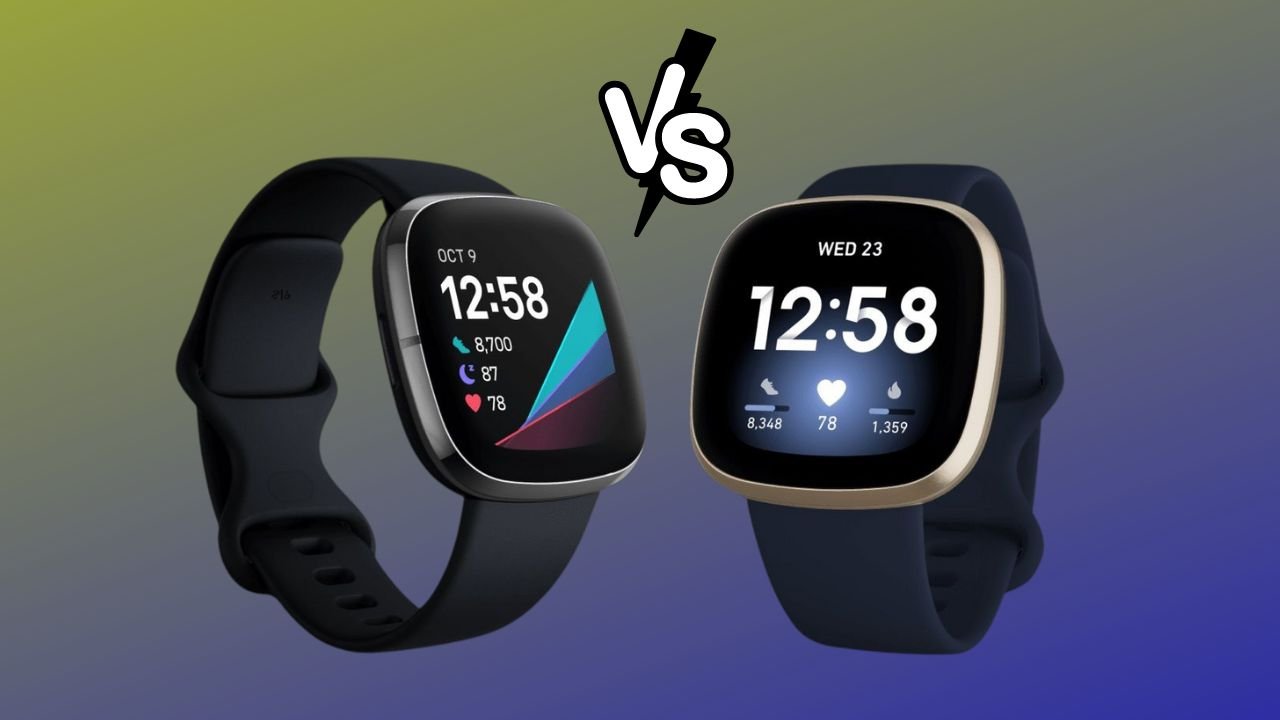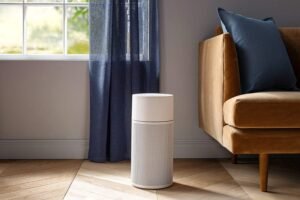
| Fitbit Sense | Fitbit Versa 3 |
 |  |
| BUY NOW | BUY NOW |
| PROS | PROS |
| ✔️High-end, premium design. ✔️Improved quick-release straps. ✔️(Mostly) accurate GPS and heart rate sensors. ✔️Skin temp sensor provides useful data. ✔️Detailed sleep tracking. ✔️6-day battery life. | ✔️Decent battery life. ✔️Pretty accurate health tracking. ✔️Built-in GPS. ✔️Google Assistant and Alexa support. ✔️Speaker with phone call support. ✔️Good price. |
| CONS | CONS |
| ❌Bad inductive button. ❌EDA and ECG sensors needs refining. ❌Fitbit OS still needs work. | ❌Very small app library. ❌Onboard music limited to two services. ❌Capacitive button isn’t ideal. ❌Proprietary charging cable. |
In this post, I’ll discuss the Fitbit Sense and Versa 3’s similarities and differences.
Similarities: Fitbit Sense vs Fitbit Versa 3
I’ll start by listing seven features that the Fitbit Sense and Versa 3 have in common.
1. Built-in GPS

The Sense and Versa 3 have built-in GPS, so you can use the Fitbit app to view your workout’s map and real-time pace and distance information without having to be connected to your phone while working out.
2. Limited Music Options

The second major similarity is that Sense and Versa 3 have the same music options. But both come with limited options:
- You cannot transfer and store your mp3 files to the Sense and Versa 3.
- Although they both have Spotify, Pandora and Deezer apps available, you need to have a paid subscription to one of these other companies to use the relevant app.
- Only Pandora and Deezer support downloading certain stations or playlists to your watch for offline playback. There are no offline playback or phone-free options for Spotify.
3. Heart Rate Sensor

The third major similarity is that the Sense and Versa 3 both have the same heart rate sensor, and every Fitbit I’ve tried in the past few years have been great at tracking resting heart rate and heart rate during moderately intense exercise. I’ve not yet had a Fitbit that can provide accurate heart rate consistently during high-intensity exercise. This is true for the updated heart rate sensor in the Sense and Versa 3.
4. Charger

Significant number four is that the Sense and Versa 3 use the same charging cable. It’s a slim design that easily attaches magnetically to the back of either device related to sharing a charger.
5. Battery Life

Major similarity number five is that the Sense and Versa 3 both have the same battery life of up to 6 days . However, that value does vary depending on your specific usage and even decreases to two days only if you are always using the always on display mode. Also using the built-in GPS will decrease your battery roughly 10% per hour of use.
6. Bands

The interchangeable bands used by the Sense and Versa 3 are extremely simple to take off and put back on. I prefer to wear the sport band while working out and the woven band at all other times, especially while I sleep.
7. Appearance

The Sense and Versa 3 have a very similar appearance, are the same size, and have a virtual haptic button. They also have the same display and utilise the same user interface, so navigating the two watches would be very similar.
Differences: Fitbit Sense vs Fitbit Versa 3
The seven main differences between the Fitbit Sense and Versa 3 are listed below.
1. Stainless Steel Ring

The first significant difference between the Sense and Versa 3 is that the Sense has a stainless steel ring, and its surrounding material reflects more on the Sense than on the Versa 3.
The Versa 3’s material appears and feels more plasticky, while the Sense’s material on the back of each device is reflective metallic. These parts are combined with electrical sensors exclusive to the Sense, allowing it to measure some things that the Versa 3 cannot.
2. ECG App

Only Sense has an ECG app, which is the second significant distinction between Sense and Versa 3.
The Fitbit ECG app enables you to perform an electrocardiogram (ECG) on demand, which can be used to analyse your heartbeat and determine whether you have Afib symptoms.
Note: The ECG app is only intended to be used by people 22 years or older and it is not available in all countries you can visit fitbit.com/ecg to see the current list of countries.
3. Heart Rate Sensor

Only Sense has high and low heart rate notifications, which is the third significant difference.
These alerts are notifications that appear on the Sense the same way as any other text or app alert. But it only happens when your heart rate has been outside your high or low thresholds for at least 10 minutes while you appear inactive, according to Fitbit Sense. The notifications can be turned on or off, and you can customise your high and low thresholds.
4. EDA Scan App

The Sense is the only device with an EDA scan app, which is the fourth significant difference.
EDA stands for Electro Dermal Activity, and the Fitbit EDA scan app can do an on-demand measurement of tiny electrical changes on your skin which may indicate your body’s response to stress.
The quick scan measurement requires you to place and rest your palm on the senses display for two minutes, after which you’ll see a summary of how many EDA responses were detected. Typically, you’ll see fewer EDA responses the calmer you are.
5. Stress Management Score

Only Sense has a Daily Stress Management Score, representing the fifth significant difference.
This score can be found in the Fitbit app and ranges from 1 to 100, where a higher number means you’re showing fewer physical signs of stress. The score considers your sleep activity and heart rate data and does not require you to use the EDA scan app to get a score.
To receive a score each day, you must wear your Sense for at least 14 hours and walk at least 500. Skin temperature is the subject of the sixth significant difference. Steps, and wear it while you sleep for at least 3 hours between 8 pm and 1 pm.
6. On-Wrist Skin Temperature Sensor

Skin temperature is the subject of the sixth significant difference.
Although the Sense and Versa 3 can provide data on skin temperature variation if you wear your watch while you sleep, only the Sense has a dedicated on-wrist skin temperature sensor. In contrast, the Versa 3 uses a device temperature sensor to estimate your skin temperature.
Another notable distinction is that the Fitbit Sense allows you to view the entire history of your skin temperature variation data. In contrast, the Fitbit Versa 3 only allows you to view the most recent seven days. Unless you have Fitbit Premium, the Versa 3 only offers a history of your skin temperature going back up to 30 days.
7. Price
It is no big surprise that there is a seventh and final significant difference.
The Sense is more expensive than the Versa 3 due to adding a few more sophisticated health sensors, apps, and features. Depending on the country and whether there are any sales, the answer to this question will vary, but in the United States, the difference is currently between $50 and $100.




